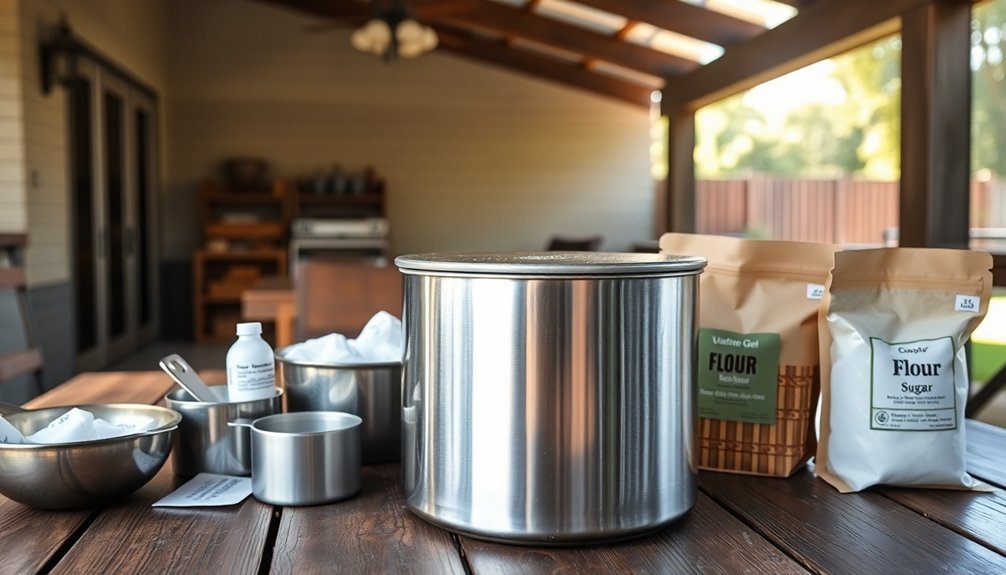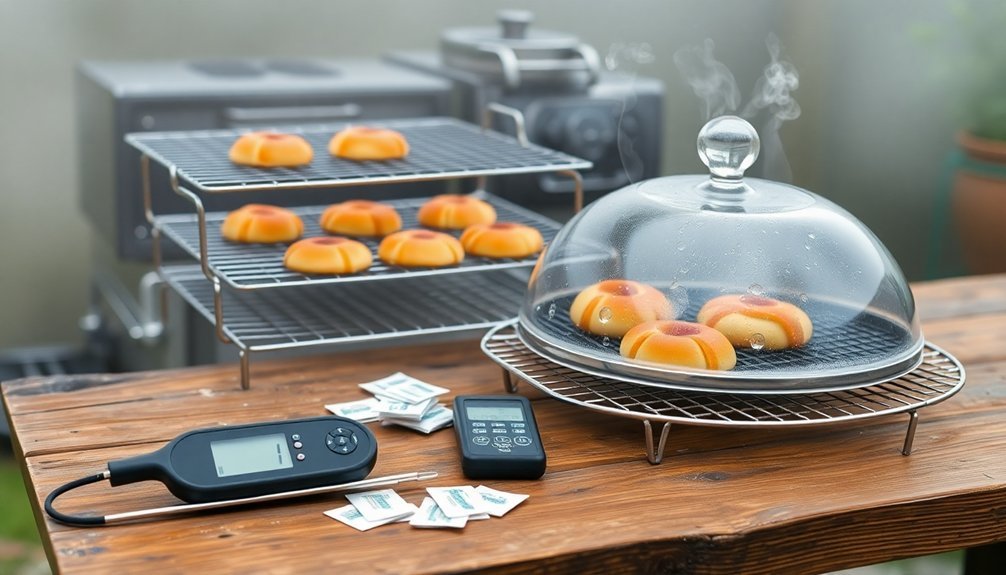To prevent moisture when baking outdoors, you'll need three key strategies. First, use a high-quality weatherproof cover with built-in ventilation for your outdoor oven when it's not in use, ensuring it fits securely over all edges. Second, control your environment by using fans, dehumidifiers, or air conditioning to reduce ambient moisture during baking sessions. Third, adjust your recipes by reducing liquids by about a quarter cup and increasing baking time by 3-5 minutes to compensate for humidity. These fundamentals will get you started, but there's much more to mastering moisture control in outdoor baking.
Smart Storage Solutions

For maximum organization, incorporate vertical shelving units and drawer systems specifically designed for outdoor use.
Your dry storage pantry should include pull-out bins and shelves with proper sealing to keep water out.
If you're working with an L-shaped outdoor kitchen layout, dedicate one side to storage, keeping your baking supplies organized and readily accessible while maintaining proper moisture control. Consider installing weather-resistant materials for optimal protection against moisture and corrosion.
Protecting Your Outdoor Oven
Protection of your outdoor oven requires a thorough approach to moisture control. You'll need to start with a high-quality weatherproof cover that fits securely over your oven's edges. During periods of non-use, guarantee you've covered the entire structure, particularly in cold climates where moisture damage is more likely. A proper cover should include built-in ventilation features to prevent condensation buildup.
| Protection Area | Key Action | Maintenance |
|---|---|---|
| Chimney | Install flue cap | Check monthly |
| Oven Door | Keep tightly sealed | Inspect seals regularly |
| External Surface | Apply protectant | Reapply quarterly |
To prevent moisture intrusion, you'll want to seal the flue pipe or consider removing it completely during extended non-use periods. Keep the oven door firmly closed when not in use, and apply a stainless steel protectant to metal components to prevent corrosion. Don't forget to perform regular firings to maintain ideal dryness.
For long-term protection, establish a routine maintenance schedule. Rake coals forward during use to cover the oven floor and drive out moisture. Conduct multiple firings after periods of inactivity, and regularly inspect for signs of water damage, such as cracking mortar or discoloration. If you're unsure about proper protection methods, don't hesitate to consult with professionals.
Recipe Adjustments for Humidity

You'll want to increase your baking time by 3-5 minutes to allow extra moisture to cook off. For cookies, add time in one-minute intervals while monitoring closely.
Test for doneness frequently to prevent overbaking. During particularly humid conditions, watch your batters and doughs carefully, as they may require additional adjustments. Consider reducing recipe liquids by one-quarter cup to offset moisture absorption from humid air.
Using fans, dehumidifiers, or air conditioning can help create a more controlled baking environment by reducing ambient moisture.
Frequently Asked Questions
Can Extreme Temperature Changes Affect Ingredient Quality When Baking Outdoors?
Yes, you'll find that extreme temperature changes can drastically affect your ingredients' quality outdoors. They'll alter butter's consistency, slow yeast activity, impact gluten development, and change how your ingredients function during baking.
How Do Different Altitudes Impact Moisture Levels in Outdoor Baking?
You'll find that higher altitudes cause faster moisture loss due to lower air pressure. Your baked goods will dry out quicker, so you'll need to increase liquid content and adjust baking temperatures accordingly.
What Natural Ingredients Work Best as Moisture Absorbers in Outdoor Baking?
You'll find bentonite clay is your best natural moisture absorber, followed by activated charcoal. Both can handle more than their weight in water and won't affect your food's safety while baking outdoors.
Does Wind Direction or Speed Affect the Moisture Content While Baking?
Yes, wind direction and speed indirectly affect your baking's moisture content. You'll find that southern winds bring humidity while northern winds create drier conditions, and faster winds can increase moisture evaporation in your environment.
Are There Specific Times of Day That Work Better for Outdoor Baking?
You'll get the best results baking outdoors in early morning or late afternoon. Early mornings offer lower humidity and cooler temperatures, while late afternoons provide helpful shade and decreasing temperatures for better control.
In Summary
You'll find that baking outdoors can be just as rewarding as indoor baking when you've taken the right precautions against moisture. Store your ingredients properly, shield your outdoor oven from the elements, and adjust your recipes to account for humidity. With these three simple strategies, you'll prevent soggy baked goods and guarantee your outdoor baking adventures are successful every time.





Leave a Reply